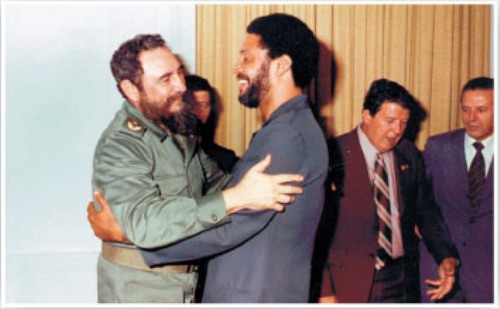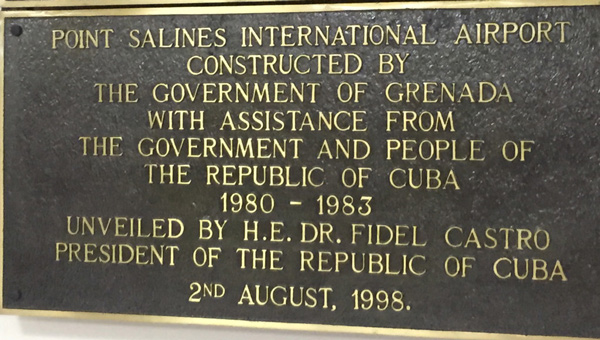Cuba in the Grenada Revolution
By Sheyla Hirshon

HAVANA TIMES — While there is no specific section on Cuba’s involvement with the Grenada revolution, details of this appear as a recurring theme in the book The Grenada Revolution in the Caribbean Present by Shalini Puri.
Cuba was one of many influences on Maurice Bishop’s formation as a leader and on the New Jewel Movement, as were many other culturally and politically radical groups that abounded in the Caribbean region in the 70s.
As such, the New Jewel Movement was fundamentally a national-democratic, anti-imperialist revolution grounded in the needs of the island. It “departed from the economic formulas of the Soviets and the Cubans” (p 42) to focus on a multiclass alliance and a mixed economy.
From the beginning however, the Cubans were generous in their assistance. “No nation contributed more to the Grenada Revolution than Cuba. Cuba contributed about 500 Cuban airport workers, advisors on every aspect of society, culture and technology: doctors who treated about half of the Grenadian population and trained Grenadians to become doctors, the radio station at Beausejour, [a 50-watt radio station with capacity to cover the Eastern Caribbean] and over 200 scholarships to Grenadians to study in Cuba. The legacies of that relationship endure in the fabric of everyday life even today.” (p.177)
During the revolutionary period the presence of Cubans in the country brought closeness, some marriages and some strains. There were “linguistic and cultural differences, differences in gender norms, jealousies over Grenadian women who were in relationships with Cuban men, differences in work cultures, and [strains due to] the racial attitudes of some Cubans toward Grenadians. “ (p. 179).
Nonetheless, in a poll of Grenadian opinions taken in 1984, following a year of intensive US propaganda, 94 percent of Grenadians readily acknowledged Cuban help to Grenada and 63 percent expressed a favorable attitude towards them. (cited on p. 179)
The role of Cuba in the NJMs turn towards authoritarian Party rule or in the events of Oct. 19 is unclear. Speculation and conflicting evidence abound as to whether Cuba was informed of the split in the People’s Revolutionary Government in October 1983, and whether Maurice Bishop at any point requested direct Cuban military support. It is known that Bishop changed his mind about accepting the Party decision to share leadership following a trip abroad with a stop in Cuba. Another face of this controversy hinges on a telephone call that Bishop is alleged to have made to Cuban ambassador Rizo on Oct. 18 or 19. It is likely that these things will never be known.

What is clear is that Cuba was the red flag that Ronald Reagan raised in his decision to invade. From the beginning, the Right had painted the New Jewel Movement and other movements in the region as dangerous extensions of Cuban and Soviet influence, ignoring altogether their character as autonomous national movements.
The airport, whose construction was one of the principal projects of the Revolution, became one of Reagan’s focal points. The project had actually been planned long before the Revolution as a means to boost tourism and industry and was supported by the World Bank and companies from Florida, Britain and Canada, as well as Cuba.
However, for Reagan and the US government, the planned 10,000 foot runway and the thickness of the tarmac “proved” that it was being constructed as a military airport to refuel Cuban planes, or possibly as a site for Soviet missiles.
The events of Oct. 1983 left Cuba in an untenable position. On the one hand, supporters of Bishop and Grenada’s “Revo”, like most progressive elements in the region, shared an “enduring regional belief in Cuba as a weaver of miracles and a country that sent support to those in need.” (p. 181)
Many of them hoped for direct Cuban military intervention on behalf of Bishop, and even when the first US planes were sighted, some wondered if these might be Cuban or even Soviet to “rescue” them from the Revolutionary Military Council which had taken power. These elements were bitterly disappointed by Cuba’s inaction.
Realistically, however, “Cuba’s intervention could have precipitated a US attack” and “escalated the confrontation to a global scale.”(p.180)
In addition, as Castro himself stated, the Cuban government had been placed in a “morally complex” position. Castro was close to Bishop and unequivocally condemned his murder, holding the RMC and the Grenada 17 responsible. When the invasion came, he could not fight on their side or offer help in combating the US troops.

The 784 Cubans in Grenada at the time paid the price of this “moral complexity”. Direct armed support of the Grenadians was out of the question, the commander of Cuban forces, Colonel Pedro Tortoló, had arrived on the island only the day before the invasion, and the vast majority of Cuban personnel in Grenada were not soldiers.
Still, Cuban honor was at stake, and the danger that a US victory might embolden them to attack Nicaragua. “Castro’s solution was to instruct Cubans not to open fire on the US and not to obstruct US attempts to evacuate their citizens. The Cubans were only to defend their positions at the airport and the Embassy.” (p. 187).
As Puri sees it, “heroic martyrdom was what the Cuban government expected from them.” (p 188) In the end, the best estimate of Cuban dead is 25, mostly airport and embassy workers, with some 59 wounded and 638 captured and later released.
On Nov. 14, 1983, Fidel Castro addressed a million-strong gathering in Havana to honor the Cubans killed during the US invasion, weaving this into a broader perspective of US aggression in the region and forcefully condemned the killings of October 19. There was no mention of the returned survivors.
Instead, for choosing life over martyrdom, Cubans who returned unscathed from Grenada were treated as something of an embarrassment. Tortoló was publicly disciplined for cowardice; the Cuban ambassador to Grenada Julián Torres Rizo was disgraced, and many – like Tortoló – were subsequently asked to serve in Angola.
Maurice Bishop, said to have been like a son to Castro, is still hailed in Cuba. The Grenada-Cuba Friendship Association established in 1974 is still functioning. In Grenada, a plaque was dedicated in 1998 thanking the Cuban government and the Cuban people for their assistance in building the airport. There are no monuments anywhere honoring the Cubans killed in the invasion.

Reread my comment. Never wrote that it was “OK”. I do believe that context is necessary to better understand behavior.
I’m no Reagan fan but I am more obliged to believe him over Mr.Ten Million Ton harvest.
Reagan told 13 lies in his speech the evening before the invasion which were intended to justify the invasion.
Fidel himself wrote up a list at the time and went through the lies one by one .
Anyone interested in a truer version of history than presented by Moses and the U.S. corporate ( lying) media can look this up on the net.
U.S. history is replete with many instances of the U.S. INSTALLING military dictatorships and the Moses version of the U.S. opposing military dictatorships is presented without any historical evidence of that intent in U.S. foreign policy over the past 100 years.
As we have hashed out many times before.
It’s just stuff Moses would rather not admit is true.
Wow! So it was OK for, in your own words, “the world’s greatest military power” to invade this tiny island that was no threat to anyone’s safety because Uncle Sam was getting his butt kicked for invading Lebanese soil; and because His candidates were rejected in a tiny, sovereign nation by its citizens in a free, democratic vote; and His plans for control of Iran’s political destiny and exploitation of Iran’s resources had been dashed…Sounds like a Bully Tantrum to me!
Instead of sweeping it under the historical carpet with such empty pretexts as you’ve said here, this is proof patent of the nature of the “Monster” as José Martí so amply described the USA. The story of Grenada has a little known connection to the CIA and the Apartheid Regime of South Africa that dates back to the dictatorship of Eric Gairy, who was the Nation’s first Prime Minister after Grenada became independent from British Colonial rule.
Knighted by the Queen of England for doing everything the British ambassador told him to do, “Sir” Eric became a despot, organized a crew of a hundred or so thugs, the feared Mongoose Squad, with license to terrify and control the small population and maintained himself in power by brutal means.
In 1976, a customs inspector in Halifax harbor (Nova Scotia, Canada), noticed that the weight of steel, water pipes bound for Grenada exceeded considerably what it should had been and suspecting contraband, pulled them aside. Upon close inspection the “pipes” turned out to be the rifled barrels for new and longer range, Howitzer cannons sent from a farm straddling the USA/Canada Border which was exposed by the subsequent investigation as a CIA owned and operated facility. The barrels were manufactured and tested in the USA side, brought across at night, crated and mailed out from Canada to Grenada, where they were transfered to a South Africa bound ship in order to get around U.N imposed, international sanctions against the White Supremacist Regime to which the USA was a signatory.
Once Maurice Bishop overthrew “Sir” Eric and opened relations with Cuba and Nicaragua, the CIA lost another convenient “asset” to carry on their nefarious affairs in the Caribbean and elsewhere. I met Mr. Bishop when he came to Toronto and spoke at U of T, where I was a member of a sponsoring organization. I also met Bernard Coard, the jerk that assassinated him in cold blood and opened fire on an unarmed crowd in Granada shortly after. He, unwittingly or not, provided the excuse the USA needed to claim “American lives were in danger” and invade, murder Cubans and Grenadians and repossess the Island.
Heroic martyrdom, is frequently requested by those too valueble to participate themselves in such glory. Death can be inconvenient.
Context is everything when it comes to the US invasion of Grenada. Just two days before 243 Marines had been killed by terrorists in Beirut. It had been less than 2 years since the US had been embarrassed in Iran. Nicaragua had recently elected an anti-US government. Against this backdrop, President Reagan was hard-pressed to sit by and allow another totalitarian military regime to threaten the safety of Americans.